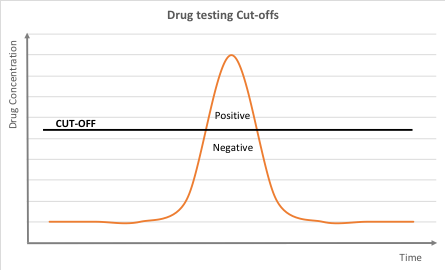Understanding the different methods of drug testing available is important to help select the best approach for your workplace.
When someone consumes drugs, alcohol or medications these substances are processed by the body and can be detected later in the person’s body fluids. Traces of drugs or their metabolites (break down products) can be found in a donor’s blood, urine, oral fluid (saliva) and hair.
Anyone who is under the influence of medication, illegal drugs or alcohol poses a potential risk in the workplace. The extent of their impairment is difficult for others to assess. If an intoxicated person makes a mistake, it can have dangerous consequences for themselves as well as their co-workers, customers and work equipment. A workplace accident is not only a threat to the safety of employees, but can also result in considerable damage to a company‘s reputation.
Despite this, drug and alcohol testing in workplaces can be a contentious issue. Understanding the types of testing available and the testing process is important to help select the most appropriate testing method for your workplace.
The two most commonly used methods for drug testing in Australia are urine testing and saliva testing. Each of these methods offer different advantages and limitations. Understanding these testing methods assists in selecting the most appropriate testing method in workplaces settings and for other applications.
What drugs can be tested for?
Workplace testing standards in Australia indicate testing for the most frequently abused illicit and prescription drugs. All of these drugs have the potential to cause impairment to performance, reaction times and judgement. The table below listed the most commonly tested substance. Other drugs may be tested for depending on the circumstances.
| Abbreviation | Drug Class | Drug Names |
|---|---|---|
| OPI | Opiates | Codeine, Morphine, Heroin, Dihydrocodeine |
| AMP | Amphetamines | Dexamphetamine, MDA |
| MET | Methamphetamines | ICE, Speed, MDMA, MBDB |
| COC | Cocaine | Cocaine, Crack Cocaine |
| THC | Cannabis | Cannabis |
| BZO | Benzodiazepines | Alprazolam, Nitrazepam, Diazepam, Temazepam |
| Drug Group | Saliva | Urine |
|---|---|---|
| Opiates | 24hrs | 3 days |
| Amphetamines | 24-36hrs | 3-4 days |
| Methamphetamines | 24-36hrs | 3-4 days |
| Cocaine | 12-24hrs | 3-4 days |
| Cannabis | 8-24hrs | 3-30 days |
| Benzodiazepines | up to 12 hrs (not slow release) | up to 2 weeks |
| O x y | 24hrs | 3 days |
| Features of Saliva Testing |
|---|
| Less intrusive |
| Collection is easily observed |
| Difficult to adulterate |
| Immediate drug detection after use |
| Current and recent drug use identified, similar to blood testing |
| Applications suited to Saliva Testing |
|---|
| Random workplace testing |
| Post-incident testing |
| Return to work testing |
| Reasonable cause or Suspicion testing |
Urine testing
Urine drug testing is considered more intrusive and can be subject to adulteration (tampering), however the longer window of detection means it is particularly useful for certain testing applications such as pre-employment testing where a longer historical view is beneficial in assessing an applicant. In addition, there tends to be a wider range of drugs tested for which can be important in certain fields such as rehabilitation or drug monitoring programs.
| Features of Urine Testing |
|---|
| Considered more intrusive |
| Detects inactive metabolites eg THC-COOH |
| Wider window of detection captures a longer history of drug use |
| Identifies general drug use patterns, as opposed to fitness for work |
| Applications suited to urine testing |
|---|
| Pre-employment testing |
| Return to work testing |
| Random testing where a historical view is required |
| Rehabilitation drug level monitoring |
Hair Testing
Hair testing is a less commonly used method of drug and/or alcohol detection due to its relatively invasive nature. The long window of detection and historical view makes this method particularly applicable in industries where monitoring of long term or complete abstinence from drugs or alcohol is required.
Hair testing can also be conducted to fulfil court orders or for individuals wishing to demonstrate abstinence from drug or alcohol use.



